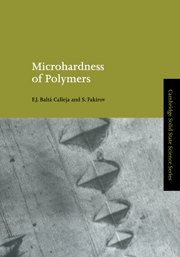Book contents
- Frontmatter
- Contents
- Preface
- Chapter 1 Introduction
- Chapter 2 Microhardness determination in polymeric materials
- Chapter 3 Microhardness of glassy polymers
- Chapter 4 Microhardness of crystalline polymers
- Chapter 5 Microhardness of polymer blends, copolymers and composites
- Chapter 6 Microhardness of polymers under strain
- Chapter 7 Application of microhardness techniques to the characterization of polymer materials
- Author Index
- Subject Index
Chapter 3 - Microhardness of glassy polymers
Published online by Cambridge University Press: 23 October 2009
- Frontmatter
- Contents
- Preface
- Chapter 1 Introduction
- Chapter 2 Microhardness determination in polymeric materials
- Chapter 3 Microhardness of glassy polymers
- Chapter 4 Microhardness of crystalline polymers
- Chapter 5 Microhardness of polymer blends, copolymers and composites
- Chapter 6 Microhardness of polymers under strain
- Chapter 7 Application of microhardness techniques to the characterization of polymer materials
- Author Index
- Subject Index
Summary
Introduction to glassy polymers
The glass transition
When a polymer is cooled down from the liquid or rubbery state, it becomes much stiffer as it goes through a certain temperature range. This stiffening is the result of one of two possible events: crystallization or glass transition. For crystallization to occur, the polymer molecules must be sufficiently regular along their length to allow the formation of a crystalline lattice and the cooling rate must be slow enough for the crystallization process to take place before the molecular motions become too sluggish. When the polymer fails to crystallize for either reason, the amorphous, liquid-like structure of the polymer is retained, but the molecular motion becomes frozen-in and the material turns into a glass. Such a glass transition occurs over a finite temperature interval, but is still realized abruptly enough to merit the term ‘transition’. The glass transition can be recognized by the change in many properties of the material, the most important one, from a practical point of view, being the increase in the modulus of the material by several orders of magnitude.
Glass formation can be achieved with many low-molecular-weight materials and with certain metallic alloys by special preparation techniques, such as rapid quenching. With polymers, the opportunities for irregularity along the chain are numerous and the crystallization rate is inherently slow. As a result, the formation of the glassy state is a more common occurrence.
- Type
- Chapter
- Information
- Microhardness of Polymers , pp. 46 - 79Publisher: Cambridge University PressPrint publication year: 2000

